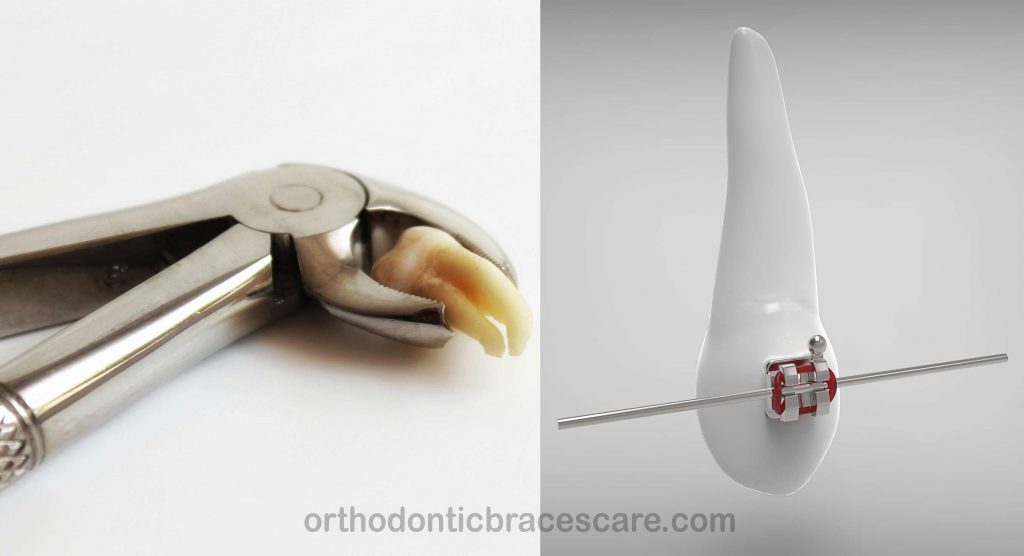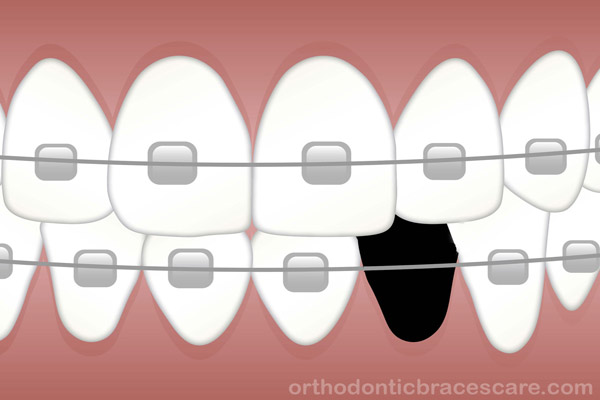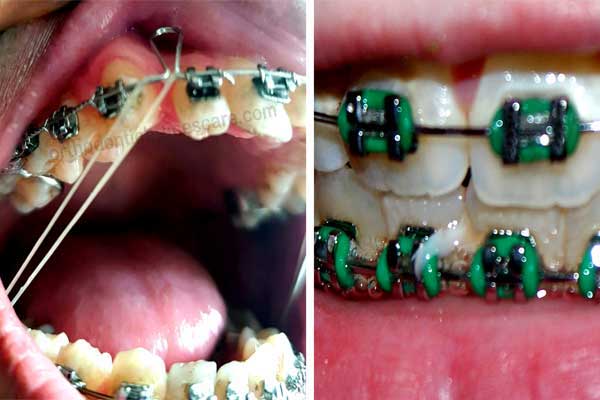Last updated on July 26th, 2022 at 02:49 pm
When someone plans to get braces for teeth straightening, the first question that comes into his or her mind is, can you have braces without removing teeth?
You can get braces without removal of any teeth if you have spacing, mild overbite, or misaligned teeth that need to be corrected. However, teeth may require to be removed when you have severe bite problems. Whether the teeth will be removed depends on the space in the jaw to realign teeth properly and the condition of your bite.
Always keep in mind that treatment planning varies from person to person as all cases are different.
But, question is, when do you need to remove teeth for braces, and how many of those teeth are extracted by the orthodontist usually?
Let’s find it out.
When can you have braces without removing teeth?

Here is the condition when we can put braces without removing teeth.
1. Gaps in between teeth
You might not need to have your teeth extracted if you get braces to close the gaps between your teeth. When there are not enough spaces between your teeth, extractions may be essential. If all that has to be fixed is the space between your upper front teeth, you might also be in luck.
2. Sufficient space
Space for teeth to align properly in your jaw is the main reason for the removal of certain teeth for orthodontic treatment. So, it’s obvious when there is enough space for teeth to realign, tooth extraction may not be indicated.
3. Mild overbite
If you have a minor overbite and enough space in your jaw to correct the bite, you may have braces without the removal of any tooth.
4. A jaw or arch expansion in children
In the growing period, orthodontic treatment can expand the arch or palate. If your orthodontist suspects space deficiency, he or she may perform a jaw or arch expansion procedure in children. So, removal of teeth may not be necessary.
5. In severe surgical cases
If a skeletal problem is the main reason for misaligned teeth, then tooth removal isn’t sufficient enough for a successful orthodontic treatment. So, a surgical procedure is necessary in this case. Examples of skeletal problems are small or big jaw and forwardly or backwardly placed jaw.
Can you get braces without removing wisdom teeth?
If wisdom teeth don’t affect the orthodontic treatment, you may have braces without removal of the teeth. However, in most cases, third molars are removed for braces to get a better outcome in the long run. But, when wisdom teeth take an abnormal place in your mouth or there is a chance of pushing your teeth and causing misalignment again after braces come off, they must remove for braces.
Still, the necessity of removal of wisdom teeth depends on the patient’s age and the severity of the cases.
Is It Necessary To Remove Teeth For Braces?
Removal of teeth for braces is necessary when your jaw bone doesn’t have enough space to hold the teeth that cause overcrowded, protruded, or misaligned teeth. But, you may not need teeth removal for orthodontic treatment in many cases if you have enough space to move teeth and make them straight.
Keep in mind that, the need for extraction of teeth to get braces depends on the severity of the cases and the age of the patient.
If it’s possible to correct an orthodontic problem without the removal of teeth, your orthodontist will never suggest an extraction.
Depending upon the situation, several teeth may need to be removed for orthodontic treatment.
But, you may be curious to know, what’ll be the treatment outcome if you get braces without the removal of teeth when it indicated. Let’s know about it.
In this article, I’ll also discuss the factors which determine the extraction. You’ll also know about which teeth may be necessary to remove for a certain condition and what are the reasons.
Is it necessary to remove 4 teeth for braces?
In many cases, removing 4 premolar teeth for the braces is necessary to gain space for the remaining teeth so that they can shift to that place and align teeth properly. Moreover, 4 teeth are mandatory to extract to maintain the balance between teeth of both jaw, otherwise, there will be a bite issue.
What if tooth removal for braces is necessary but treatment is done without removal?
Your orthodontist recommended tooth removal for braces when there is no other option. In this circumstance, if you get braces without the removal of teeth and complete treatment, the outcome of treatment may not be satisfactory. It may not look good aesthetically.
Sometimes, even if we align your teeth, the displacement may occur after a few years. Sometimes, you may have problems like instability and gum recession.
What are the side effects of removing teeth for braces?
There are no such side effects after the removal of the teeth for braces because your dentist will ensure it first if you are a good candidate for braces treatment as well as the removal of the teeth. Moreover, tooth removal for braces helps make your orthodontic treatment successful. Besides, after the removal of braces, the gaps left by the missing teeth are closed perfectly and give you beautiful smile.
When can’t you have braces without removing teeth?
It may be necessary to remove teeth for braces such as severely crowded teeth, lack of space for teeth to align in the jaw or dental arch, small jaw with severely sticking out front teeth, etc.
Conditions, where there is no need for the removal of teeth, are having enough space, less severe cases, etc.
Whatever the reason for the removal of teeth before getting braces, you should know that a qualified orthodontist will never suggest the removal of teeth unless it’s mandatory.
Even if he or she can complete treatment without any extraction, it will be easy for him and take less time. So, there must be a reason.
But, how will you know if you or your child needs the removal of teeth before getting braces?
There are some conditions in which tooth removal is necessary for braces. Your orthodontist will evaluate your overall condition of jaw and teeth and decide this.
Here are the reasons for tooth removal for braces:
1. Severe crowding
Crowding is the overlapping of one or more teeth with others. There are many reasons for crowding. It may occur due to genetic or other external factors that hamper the growth and development of the jaw, teeth, and facial structures.
Commonly, crowding occurs when the arch length is less and teeth don’t get enough space in your mouth. So, when the arch length isn’t sufficient enough to hold all teeth in the proper position, it may require extraction.
Arch length is the summation of the outer portion of the jaw bone. When the summation of the length of all teeth is more than the arch length, it means teeth won’t get enough space in your mouth.
Even if we try to rearrange teeth in the proper position, we won’t get that required space. So, to create that space, an orthodontist suggests you remove certain teeth.
Think about a garage. Suppose it can arrange 6 bikes properly. Now, what’ll happen if you try to arrange 7 bikes there?
It’s not possible. Even if it’s possible, you can’t align them nicely. So, you have 2 options. Either you have to eliminate the extra bike from the garage or you have to increase the size of the garage.
Just like the garage, your jaw can arrange a certain number of teeth. If there’s an excess in tooth material, you can’t arrange it in your jaw properly.
Even if you try to keep all the teeth, there’ll be a misalignment all the time. So, the removal of certain teeth is important to manage the space.
Braces on crowded teeth without the removal of teeth
No tooth removal may be necessary if arch expansion is done at an early age. If there is a way to increase the jaw size, called the arch expansion procedure, it can help to align teeth nicely. This can be done at a growing age.
In this procedure, the arch length is increased because a child’s growth isn’t completed. However, It can’t be sufficient for many cases and extraction becomes mandatory.
Mild crowding may not require teeth removal. Instead, proximal slicing of teeth can create some space. But, it’s not indicated in many cases.
2. Excessive protruded upper or lower teeth
Arch length deficiency or a small jaw can result in another condition. Instead of making your teeth crowded, it may cause teeth to stick out. This condition is called “proclination” or “protrusion” of teeth.
It’s also called the Class II division 1 case. This usually occurs in front teeth and lips don’t able to hide the teeth completely.
The proclination can occur in upper or lower teeth or both. In these cases, teeth may be required to remove to align them in the right place with braces.
3. Abnormal Growth of the jaw
The development and growth of the jaw can affect your dentition. Sometimes the upper jaw is larger or more forwardly placed than the lower jaw (maxillary prognathism) and sometimes the lower jaw is larger or more forwardly placed than the upper jaw (mandibular prognathism).
These cases are difficult to treat. Removal of teeth and/or jaw surgery may be necessary in this case. Surgery is performed to reduce the size of a large jaw. If there is sufficient space for upper teeth, a combination of both orthodontic and surgical treatment will correct the problem. But, this is an invasive procedure and sometimes patients don’t want to perform it. So, tooth extraction for braces is the choice.
Sometimes people don’t take orthodontic treatment from a qualified orthodontist and the surgical procedure isn’t suggested though it’s required. So, the prognosis of the treatment may be poor.
However, if the condition isn’t severe, surgery may not be necessary. Removal of teeth and orthodontic tooth movement with braces may solve the problem in this case.
The upper 1st molar and lower 1st molar maintain a relation in your mouth. It’s necessary for proper alignment of teeth.
But, if there is a problem with the growth of the jaw or other external factors, upper molars are placed forwardly or backwardly than lower molars or vice versa. To establish a molar relationship, certain teeth may need to be extracted.
4. Abnormal or extra teeth
Sometimes the size, shape, and form of a tooth can be abnormal like too large tooth, too small tooth abnormal crown size, curve root, etc. If they interfere with braces, we’ll suggest you extract the tooth.
Sometimes people have an extra tooth, called a supernumerary tooth. This should be removed to get a better outcome.
5. Poor dental health
If you have a tooth with gross caries or decay that can’t be restored, it may be removed before getting braces.
If it’s possible to preserve the tooth, you may get an implant, crown, bridge, or prosthesis before or after getting braces.
Another thing is wisdom teeth. When you have a wisdom tooth that is impacted or poorly positioned in the jaw which interferes with braces, removal of the tooth may be necessary before getting braces. But, it does not need to perform in all cases.
6. Maintaining a bite symmetry
Sometimes patients get to wonder when an orthodontist suggests extracting 2 or 4 teeth for braces treatment. But, don’t think that he or she does it without any reason. In fact, it’s essential in some cases.
In certain conditions, it’s necessary to have 2 same teeth of the same jaw. An example of this is the extraction of both upper first premolars. If we remove only one premolar, it will cause a midline shift.
Upper central incisor teeth (front 2 teeth) should remain at the midline of your face which is esthetically perfect.
Midline shift means upper central incisors move on one side from the central position which isn’t expected. So, we remove both premolar teeth to avoid this problem.
Moreover, in some cases, two same teeth of the opposite jaw are removed, It’s done to maintain your bite or occlusal relationship and preserve the function of teeth.
7. Correcting underbite or crossbite
Sometimes, in case of misalignment of teeth such as underbite or crossbite, it may be necessary to remove a certain tooth.
An underbite is a condition when the lower front teeth and jaw are more forwardly placed than the upper teeth and jaw. It’s the opposite of the proclination of upper teeth and jaw.
A crossbite is a condition when a tooth is displaced more laterally than other teeth in your jaw.
8. Preventing relapse tendency
When braces are removed after completion of treatment, your teeth may be straightened and you get a beautiful smile.
But, if there is any problem during the treatment period or treatment planning, teeth may be misaligned again. It’s called a relapse.
This can happen when your teeth need to be removed for a good outcome, but treatment is done without any extraction. It may initially give you a good smile, but in the long run, it may affect your smile again.
So, consult with an experienced orthodontist to avoid relapse tendency and follow his or her instructions for the stability of orthodontic treatment.
Which teeth are usually removed for braces and why?
First premolars are commonly removed for braces and wisdom teeth aren’t removed for orthodontic treatment purposes solely. Second premolars are also removed sometimes. Orthodontists rarely extract other teeth for orthodontic treatment.
However, there are some conditions when teeth removal may be necessary for certain teeth.
1. 4 Premolar removal for braces
First premolars
The position of first premolars is so favorable that the space gained by this can help us to correct both front and back teeth. It also doesn’t affect our smiles or looks. So, these are the most common teeth which are removed for braces. Orthodontists extract first premolars in-
- Moderate to Severe crowding cases
- Moderate to Severe protrusion cases
Second premolars
The orthodontist can also remove second premolars. In fact, it’s not always the second choice in braces treatment. Here are some reasons-
- Mild crowding
- Impaction
- Gross caries
- Open Bite
2. Front tooth removal for braces
Lower incisors
Generally, we don’t select lower incisors for extraction. It can make the situation worse. But, rarely, we may plan for an extraction when a lower incisor tooth is-
- totally out of position
- abnormal in form and shape e.g. too small or conical incisor
- severely injured
- Severe space deficiency
Upper incisors
We orthodontists also extract upper incisors rarely for orthodontic treatment as they give you a pleasing appearance. However, we can suggest you removal of an upper incisor when-
- It’s severely impacted, not come in occlusion or not visible
- It’s completely out of position
- One lateral incisor is missing. To maintain a balance between both sides, another is removed.
- It’s abnormal in form and shape
- It has gross caries or injured. The injury occurs when someone has protruded incisors.
Canines
Canines are the most important teeth which help guide alignment in orthodontic treatment. They also aid in function and give you a beautiful smile.
Without them, your face becomes flattened and facial balance is also lost. So, rarely a canine is extracted for braces. But, some cases can lead to its removal, such as-
- Severe impaction. Canine is common after wisdom tooth which gets impacted under gums.
- Poorly placed with other teeth which can’t be corrected.
3. Molar removal for braces
First molars
First molars are important for mastication or chewing. It’s not commonly extracted for orthodontic treatment. It’s also not helpful for proper teeth alignment. However, some reasons for its removal are-
- Mild crowding cases
- Protrusion cases
- Open Bite cases
- Gross caries
Second molars
Second molars are also very important for mastication or chewing and rarely extracted. Reasons for removal of second molars can be due to-
- Move the first molar behind to get space for the front teeth
- Prevent impaction of wisdom teeth
4. Wisdom tooth removal for braces
Generally, orthodontists don’t remove wisdom teeth or third molars for braces only. However, in certain conditions, wisdom tooth removal may be necessary, such as-
- Impaction
- Gross caries
- Abnormal size, shape, or position which interferes with the treatment, etc.
You can read my other article regarding whether wisdom teeth affect braces or not and know in detail.
How many teeth need to be removed for braces?
The number of teeth to be removed for braces depend on the severity of the cases and treatment goal. It may vary from 1 to 4 teeth or more depending upon the situation.
What are the alternatives to tooth removal for braces?
An alternative to tooth removal for braces is an arch expansion or palate widening procedure that’s performed in growing children. Adults may not get benefits from it. Another alternative is the surgery of the jaw that’s necessary in severe cases like skeletal or jaw growth problems.
The reason for asking this question is either you are afraid of extraction or you don’t trust your orthodontist.
If you consult an experienced and qualified orthodontist, you shouldn’t get worried. He or she will never suggest an extraction unless it’s the only choice.
Still, if there is an alternative, your orthodontist will inform you and suggest the best option.
You can say an extraction may be an alternative to the surgery in some cases, as you may not like the surgery.
Moreover, clear aligners are also not an alternative to tooth removal for braces. Braces can accomplish the same thing without the extraction, and the results will be the same. Keep in mind that, the main concern is the space in your jaw that is required to align teeth properly, not the braces.
But, always respect your orthodontist’s decision and keep the faith.
Takeaways
In a variety of situations, including tooth crowding, inadequate arch length, proclination, underbite, etc., tooth removal may be required for braces. Your orthodontist will never suggest an extraction if it is not necessary. So, before having braces, always seek the advice of a qualified orthodontist.

Dr. Pallab Kishore, MS in Orthodontics and owner of Orthodontic Braces Care, shares expert tips on braces, aligners, and oral health from 10+ years of experience.



Comments are closed.